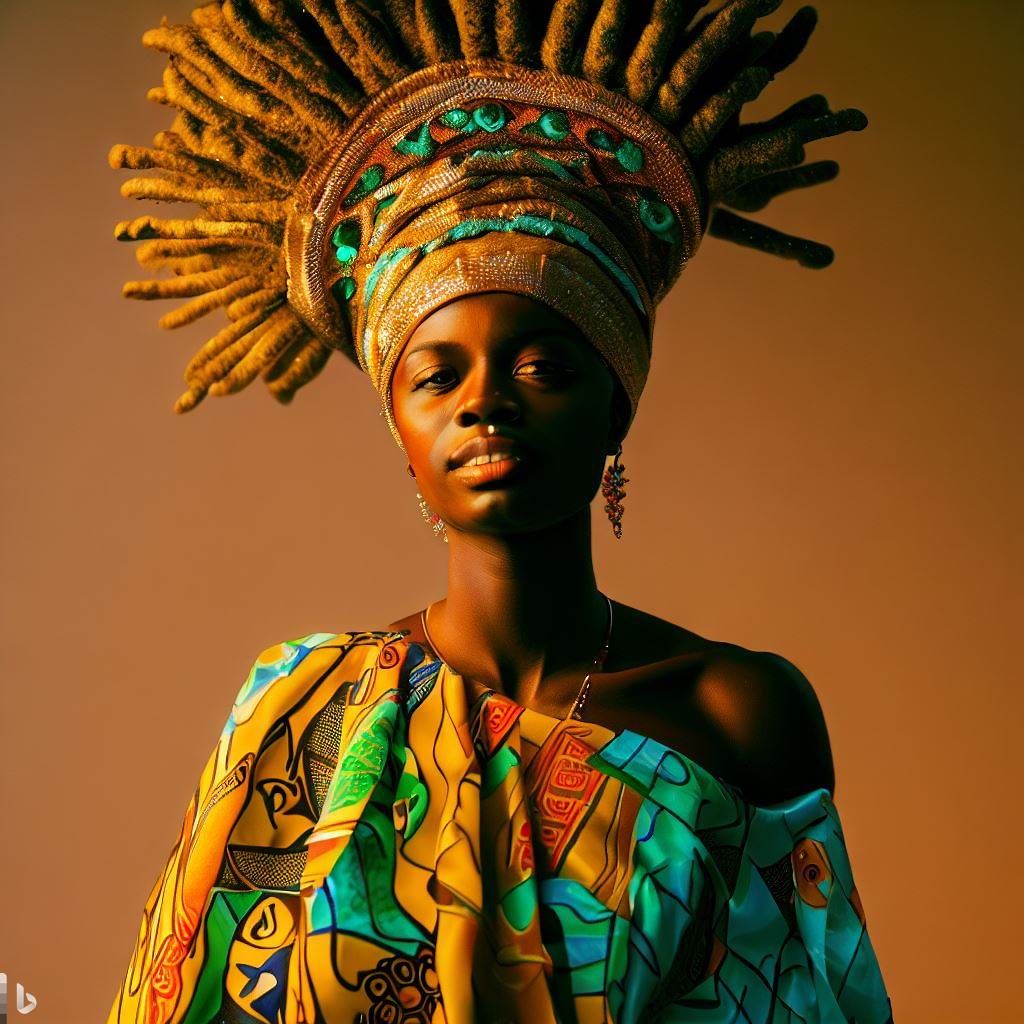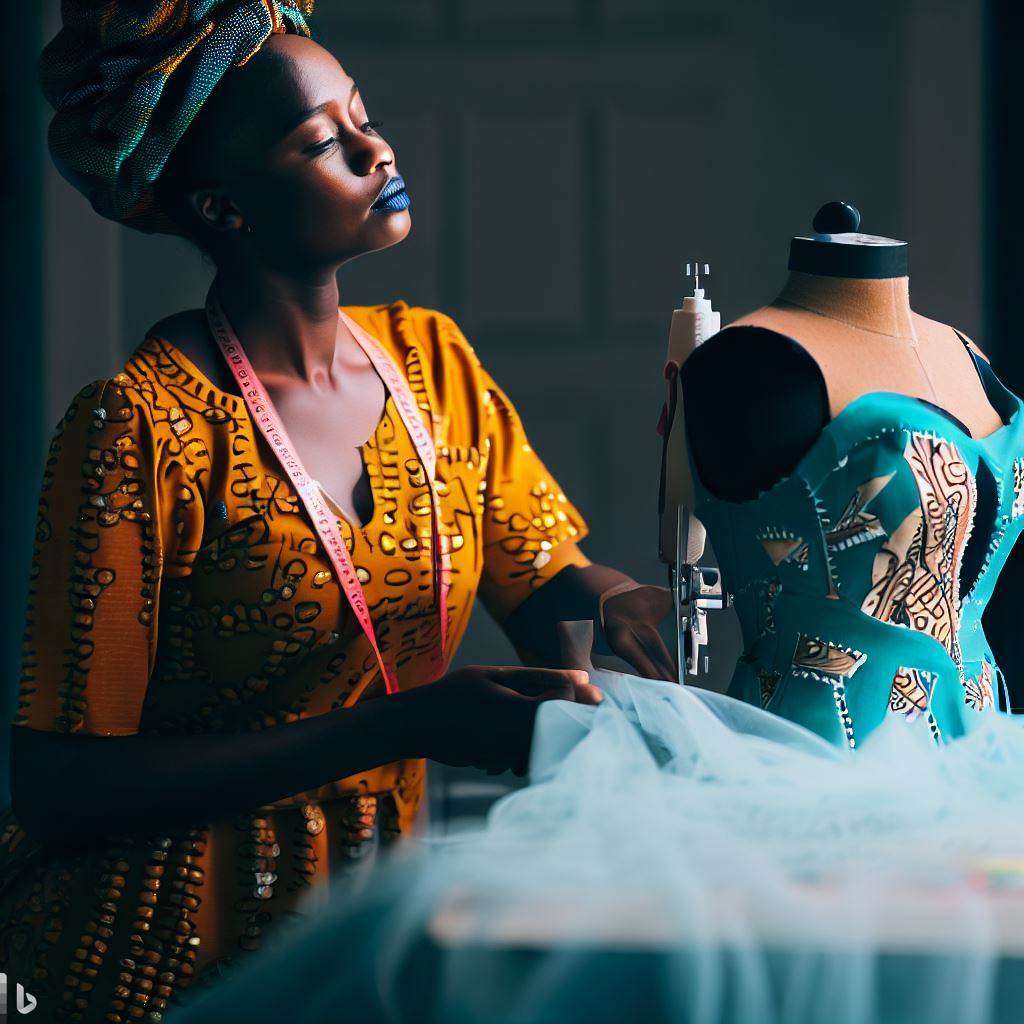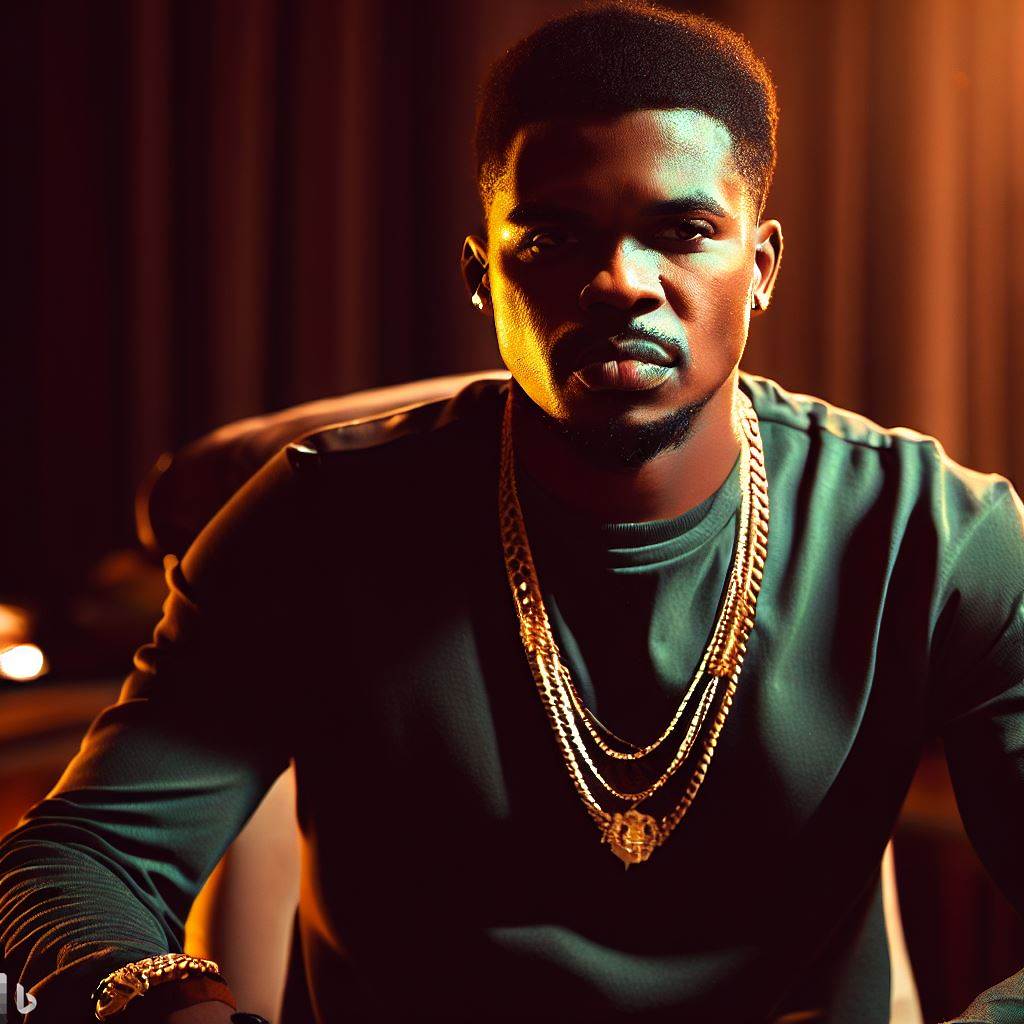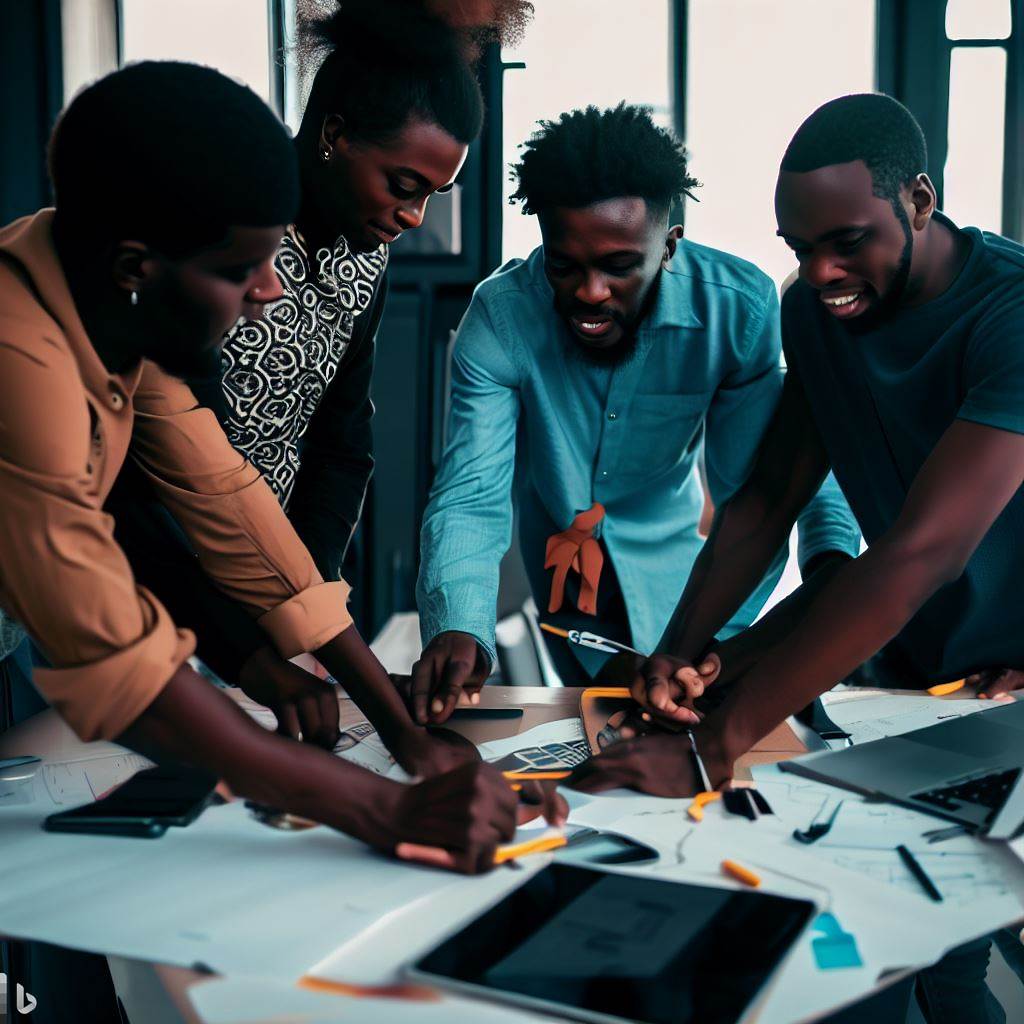Introduction
Cultural influence is a key factor in Nigerian costume design practice, shaping design choices.
Understanding the importance of cultural influence helps to appreciate and respect Nigerian costume designs.
Cultural influence in Nigerian costume design bridges tradition and creativity, yielding vibrant attires that narrate stories.
- Preserving Heritage: Cultural influence preserves Nigeria’s diverse ethnic heritage through attire representation.
- Visual Storytelling: Costumes communicate cultural stories, traditions, and societal roles without words.
- Identity Expression: Attires showcase individual and communal identities, fostering a sense of belonging.
- Global Recognition: Nigerian designs gain international acclaim, promoting the nation’s rich cultural tapestry.
- Economic Value: The global demand for Nigerian-inspired fashion generates income, supporting local artisans and industries.
- Social Significance: Traditional attire remains pivotal in ceremonies, ceremonies, and celebrations, uniting communities.
- Innovation Fusion: Cultural influence spurs creativity, as designers blend tradition with contemporary aesthetics.
- Education and Awareness: Cultural costumes educate the world about Nigeria’s diverse cultural nuances.
- Symbolism and Spirituality: Attires often carry symbolic meanings and spiritual connections, deepening cultural understanding.
- Bridge to the Past: Nigerian costumes link present generations to their ancestors, honoring customs and lineage.
In essence, cultural influence shapes Nigerian costume design, rendering each attire a vessel of history, art, and self-expression.
Historical Overview of Nigerian Costume Design
Overview of traditional Nigerian clothing
Nigerian traditional clothing reflects the rich cultural heritage of the diverse ethnic groups in the country.
Each ethnic group in Nigeria has its unique style of dress, influenced by its history and traditions.
Traditional Nigerian clothing gains recognition for vibrant colors, intricate patterns, and utilization of indigenous fabrics.
Common garments include boubou, agbada, dashiki, wrappers, and head-ties.
Both men and women wear the flowing gown known as Boubou, while men often don the grand robe called agbada.
Termed Dashiki, loose-fitting shirts are complemented by rectangular fabric pieces used as body wrappers.
Elaborate headscarves worn by women, referred to as gele or head-ties, signify their social status or occasion.
Traditional Nigerian clothing is not just a fashion statement but also a symbol of identity and cultural pride.
Evolution of Nigerian costume design over time
Over the years, Nigerian costume design has evolved, influenced by external factors and global trends.
European styles and fabrics significantly influenced Nigerian clothing during the colonial era.
Traditional garments became less popular, and Western clothing started dominating the fashion scene.
In the post-colonial period, there was a resurgence of interest in traditional Nigerian clothing.
Fashion designers began incorporating indigenous fabrics and motifs into their designs.
The Nigerian fashion industry experienced a boom in the 1960s and 1970s, with the rise of Nigerian designers.
These designers, such as Deola Sagoe and Ituen Basi, played a significant role in promoting Nigerian costume design.
In recent years, there has been a renewed focus on Nigerian fashion, both locally and internationally.
Nigerian designers are now showcasing their designs on global runways and gaining recognition for their creativity.
They are incorporating traditional elements into contemporary designs, creating a fusion of the old and the new.
Nigerian costume design is no longer limited to traditional occasions.
It has become integrated into Nigerian costume design and has integrated into everyday wear, moving beyond its former confinement to traditional occasions.
People celebrate it as a form of cultural expression and as a way to preserve Nigeria’s rich heritage.
Nigerian costume design has also become a source of income and employment, contributing to the economy.
Through their designs, Nigerian designers are promoting and preserving Nigerian culture on a global scale.
Cultural Diversity in Nigerian Costume Design
Explore the rich diversity of Nigerian cultures
Nigeria stands as a country renowned for its extensive cultural diversity.
With over 250 ethnic groups, each with their own unique traditions, the Nigerian costume design practice showcases a rich tapestry of cultures.
- Yoruba Culture: The Yoruba culture is one of the most prominent cultural groups in Nigeria. Their costume design stands out for vibrant colors and intricate patterns.
Adire, a tie-dye fabric, is a significant element in Yoruba traditional attire. - Igbo Culture: The Igbo people are another major ethnic group in Nigeria.
They characterize their costume design with bright colors, intricate beadwork, and the utilization of a fabric known as George.
It is common to see men wearing the Isiagu, a traditional embroidered top. - Hausa-Fulani Culture: The Hausa-Fulani people, mainly found in Northern Nigeria, have a unique costume design that reflects their Islamic heritage.
Women wear colorful wrappers called abaya, while men wear flowing gowns called babban riga, often complemented with a cap known as a fila. - Edo Culture: Edo people, from the southern part of Nigeria, have a rich cultural heritage seen in their costume design.
Traditional attire includes the buba, an embroidered blouse or shirt, and the wrapper, a piece of fabric tied around the waist.
Influence of regional traditions and customs on costume design
The practice of Nigerian costume design draws significant influence from the regional traditions and customs of diverse ethnic groups.
- Symbolism: Costumes often carry symbolic meanings, reflecting cultural values and beliefs.
For instance, the Igbo gele, a headwrap, conveys wealth and social status, while the Yoruba gele is donned to display elegance and beauty. - Materials: Nigerian costume design incorporates a wide range of materials, including locally sourced fabrics like aso-oke, adire, and ankara.
These materials not only represent cultural identity but also contribute to the sustainability of local textile industries. - Traditional Techniques: Traditional costume design techniques, such as weaving, dyeing, and embroidery, are still practiced in many Nigerian communities.
These techniques have been transmitted across generations and play a role in preserving cultural heritage. - Festivals and Ceremonies: Festivals and ceremonies play a significant role in Nigerian costume design practice.
People dress in elaborate costumes during events such as weddings, coronations, and cultural festivals, showcasing their cultural pride and identity. - Global Influences: While Nigerian costume design practice is rooted in rich cultural traditions, it also incorporates global influences.
Western-style clothing, such as suits and dresses, is often fused with traditional elements to create unique and contemporary designs.
In short, Nigerian costume design practice highlights the cultural diversity and richness of the country.
It showcases the influence of regional traditions and customs on costume design, reflecting the values, beliefs, and identities of different ethnic groups.
By embracing traditional techniques and materials, while also incorporating global influences, Nigerian costume design continues to evolve and thrive in the modern world.
Read: Influence of Nollywood on Nigerian Digital Marketing
Traditional Nigerian Designs and Techniques
Description of Key Traditional Designs and Motifs
- Ankara: Ankara is a popular fabric choice in Nigerian costume design. It is a colorful and vibrant cotton fabric with various prints and patterns inspired by African culture and nature.
- Adire: Adire is a traditional Nigerian fabric known for its tie-dye designs.
It is made using resist-dyeing techniques, where certain parts of the fabric are tied or stitched to create unique patterns before dyeing. - Aso Oke: Aso Oke is a hand-woven fabric made by the Yoruba people of Nigeria. It is usually woven with vibrant colors such as gold, red, and blue.
Aso Oke is commonly used in traditional Nigerian ceremonies and celebrations. - Kente: Although originating from Ghana, kente has become a popular traditional Nigerian fabric.
Characterized by bright, colorful, and intricate patterns, it embodies cultural symbols and proverbs.
Techniques Used in Creating Nigerian Costumes
In Nigerian costume design, artisans employ various active techniques to create intricate and unique garments.
- Beading: Small beads are attached to the fabric, crafting elegant and detailed patterns.
- Embroidery: Colorful threads decorate fabric, forming beautiful motifs and designs.
- Appliqué: Fabric pieces are sewn onto a base, adding texture and decoration.
- Tie and Dye: Fabric is tied, and dyed, yielding vibrant and distinct patterns.
- Batik: Wax-resist creates intricate patterns before dyeing fabric.
- Hand Weaving: Skilled artisans manually interlace threads on a loom, producing complex designs.
- Adornment: Cowrie shells, feathers, and coins symbolize cultural status, meticulously attached.
- Layering: Strategic fabric arrangement adds depth and movement to Nigerian costumes.
These techniques are essential in creating Nigeria’s rich cultural heritage, seen in fabrics like Ankara, Adire, Aso Oke, and Kente.
Each method contributes artistic value, showcasing the nation’s influence in costume design.
These traditional designs and techniques are a testament to the country’s cultural influence in the world of costume design.

Modern Nigerian Costume Design
Contemporary Nigerian fashion designers
- The Nigerian fashion industry has witnessed the rise of talented and innovative fashion designers.
- These contemporary designers bring a fresh and modern perspective to Nigerian costume design.
- They have gained recognition both locally and internationally for their unique designs and craftsmanship.
- Some notable Nigerian fashion designers include Deola Sagoe, Lisa Folawiyo, and Mai Atafo.
- These designers have been instrumental in pushing the boundaries of Nigerian costume design.
Fusion of Tradition and Modernity in Costume Design
- Modern Nigerian costume design often involves a fusion of traditional and contemporary elements.
- Designers incorporate traditional fabrics, motifs, and techniques, but with a modern twist.
- This fusion creates a unique and dynamic aesthetic that reflects Nigeria’s rich cultural heritage.
- Modern designs frequently reimagine traditional Nigerian textiles like Aso Oke, Adire, and Ankara.
- The incorporation of traditional elements in modern costume design helps to preserve and celebrate Nigerian culture.
Read: The Rise of Nollywood: An Insider’s Perspective
Cultural Influences in Nigerian Costume Design
Influence of Nigerian tribal cultures on costume design
- Nigerian tribal cultures play a significant role in shaping the country’s costume design practices.
- Each tribe has its unique clothing styles and traditions that influence modern costume designs.
- For instance, the Yoruba tribe gained recognition for its vibrant and intricate textile patterns.
- The Igbo tribe favors vibrant and symbolic motifs in their costumes.
- The Hausa tribe gained renown for embellishing elegant, flowing clothing styles with embroidery.
- Contemporary Nigerian fashion reflects these tribal influences, highlighting a vibrant cultural heritage.
Incorporation of symbols and motifs with cultural significance
- Nigerian costume designers often incorporate symbols and motifs that hold cultural significance in their designs.
- For instance, Adire represents a traditional Nigerian fabric that artisans dye using indigo, decorating it with intricate patterns.
- In Nigerian costume design, Adinkra symbols from Ghana find use in representing various ideas or concepts.
- These symbols and motifs serve as a way to honor African heritage and preserve cultural identity.
- The use of these elements in costume design also helps to educate and raise awareness about Nigerian culture.
- By incorporating these symbols, designers create garments that are not only fashionable but also tell a story.
In fact, tribal cultures heavily influence Nigerian costume design, incorporating symbols and motifs of cultural significance.
The diverse tribal cultures in Nigeria contribute to the richness and uniqueness of their costume designs.
Whether it’s the vibrant textile patterns of the Yoruba tribe or the symbolic motifs used by the Igbo tribe,
Nigerian designers embrace their cultural heritage. By incorporating symbols and motifs, they create garments that not only showcase their creativity but also honor their African roots.
Nigerian costume design serves as a platform for preserving and celebrating Nigerian culture, while also making a mark in the global fashion industry.
Global Impact of Nigerian Costume Design
Recognition of Nigerian fashion on the international stage
Nigerian costume designs have gained recognition and appreciation in the global fashion industry.
Designers such as Lisa Folawiyo and Deola Sagoe have showcased Nigerian fashion on international runways.
The unique and vibrant Nigerian designs have captivated fashion enthusiasts worldwide.
Nigerian designers have received accolades and awards for their innovative and culturally rich creations.
Through collaborations with international brands, Nigerian fashion has reached a wider global audience.
Influence of Nigerian designs on global fashion trends
Nigerian costume design practice has greatly influenced global fashion trends. African prints, such as Ankara and Adire, originating from Nigeria, have become popular globally.
High-profile celebrities like Beyoncé and Rihanna have worn Nigerian-inspired outfits.
Nigerian designs have influenced the use of vibrant colors and bold patterns in mainstream fashion.
The incorporation of traditional Nigerian elements into modern clothing has become a global trend.
Nigerian fashion has inspired designers worldwide to infuse their collections with African aesthetics.
Renowned fashion houses incorporate Nigerian fabrics and motifs into their collections.
The global visibility of Nigerian fashion has led to an increased demand for African-inspired clothing.
Basically, Nigerian costume design practice has made a significant impact both in terms of recognition and influence on the global fashion stage.
The unique and vibrant designs have gained international recognition, with Nigerian designers showcasing their creations on runways around the world.
Furthermore, Nigerian fashion has impacted global trends, popularizing African prints and celebrities donning Nigerian-inspired attire.
The incorporation of traditional elements and the use of Nigerian fabrics have become global trends, inspiring designers worldwide.
As Nigerian fashion continues to evolve and gain prominence, its global impact will only grow stronger.
Read: Behind the Scenes: Nigerian TV Production Careers
Challenges and Opportunities in Nigerian Costume Design
Preservation of traditional costume design in a rapidly changing world
- Lack of awareness and appreciation for traditional costume design among the younger generation.
- Rapid globalization and Western influence leading to a decline in the popularity of traditional Nigerian costumes.
- Changing lifestyles and preferences, with younger Nigerians opting for more Western fashion styles.
- Limited resources and funding for the preservation and promotion of traditional costume design.
- Difficulty in finding skilled artisans and craftsmen who can create traditional Nigerian costumes.
- Limited access to traditional costume materials due to urbanization and industrialization.
- Accessibility and affordability of mass-produced, imported costumes make it challenging for traditional designs to compete.
- Limited opportunities for education and training in traditional costume design, resulted in a dwindling number of skilled designers.
Emerging opportunities and platforms for Nigerian designers
- Growing interest in Afrocentric fashion and African cultural heritage on a global scale.
- Strengthening of the Nigerian fashion industry with the emergence of fashion weeks, exhibitions, and design competitions.
- Increasing demand for unique and authentic fashion pieces that reflect Nigerian identity.
- Utilization of social media platforms to showcase and promote Nigerian costume designs to a wider audience.
- Collaborations with international designers and fashion brands, providing exposure and recognition to Nigerian designers.
- Tourism and cultural events showcasing Nigerian traditional costumes, creating opportunities for designers to showcase their work.
- Rise of online marketplaces and e-commerce platforms, enabling Nigerian designers to reach a global customer base.
- Support from the government and non-governmental organizations in promoting and preserving Nigerian costume design.
- Creation of design incubators and fashion schools that focus on traditional costume design, nurturing young talents.
- Increased recognition and celebration of Nigerian costume design through fashion awards and industry recognition.
- Empowerment of local communities by supporting their traditional costume design practices and creating sustainable livelihoods.
- Integration of traditional costume design elements into contemporary fashion, creating a fusion of tradition and modernity.
- Participation in international fashion events and exhibitions, providing Nigerian designers with opportunities for networking and collaborations.
- Access to crowdfunding platforms, allows designers to raise funds for their projects and collections.
- Increased access to technology and digital tools, enabling designers to explore innovative techniques in costume design.
Essentially, Nigerian costume designers face various challenges in preserving traditional designs.
However, they also have numerous opportunities in emerging platforms and growing interest in Afrocentric fashion.
By leveraging these opportunities, Nigerian designers can continue to showcase the beauty and richness of traditional costumes while adapting to the demands of a rapidly changing world.
Read: The Role of Costume Designers in Nigeria’s Nollywood
Conclusion
Traditional Nigerian costumes showcase individual ethnic identities and societal values. Its rich cultural heritage deeply influences Nigerian costume design practice.
Contemporary Nigerian designers infuse cultural elements into their creations. The use of traditional fabrics, motifs, and techniques is prevalent in Nigerian costume design.
Collaborations with local artisans and craftsmen contribute to the preservation of traditional practices.
Preserving cultural influence in costume design enhances cultural identity and pride. It promotes diversity and inclusivity by drawing attention to the richness of Nigerian culture.
By incorporating traditional elements, designers create unique, culturally significant pieces.
Nigerian costume design practice drives economic growth and promotes local partisanship.
Celebrating cultural influence in costume design showcases Nigeria’s cultural heritage to the world.
In closing, Nigerian costume design practice serves as a reflective medium that articulates the cultural richness of the nation.
By preserving and celebrating this cultural influence, Nigerian designers contribute to national identity, promote diversity, and drive economic growth.




